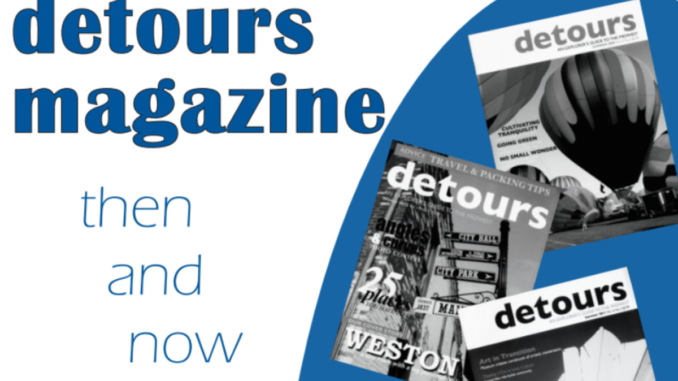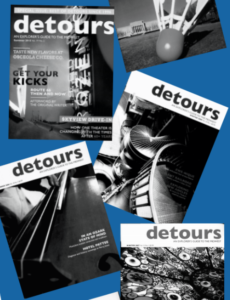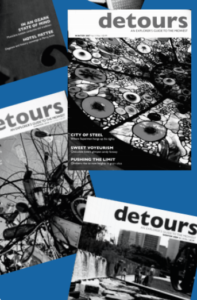
Detours Magazine is no stranger to change; from a print magazine to a fully digital publication, Detours has adapted to reflect its readers’ ever-changing needs. In a time that has required so much change and adaptation, Detours recognizes its need to change formats again and will be merging into The Index’s features section.
Founded by communication professor David Fortney and a group of students in 1995, Detours provides student journalists an opportunity to explore feature content. As a travel magazine, Detours covers getaways and experiences local to Missouri, Iowa and Illinois. Throughout the 25 years since its initial publication, Detours has highlighted a variety of destinations. From state parks to tourist towns and up-and-coming restaurants, the magazine has reported many of the experiences that define the Midwest.
Elizabeth Clark, dean of the School of Social and Cultural Studies, came to work at Truman State University in 2001. By this point, Detours had become an established entity, publishing multiple issues each year. Clark said she remembers looking forward to the release of new issues of Detours and still has a collection of print copies in her office.
“I really enjoyed seeing the new Detours editions come out,” Clark said. “They were so visually appealing; the images, as well as the writing, were so well done, and they were a nice magazine to have around when you just wanted to sit and read something to relax.”
 As the needs of Detours’ audience changed, the magazine began to publish some stories online and eventually moved to an exclusively online format.
As the needs of Detours’ audience changed, the magazine began to publish some stories online and eventually moved to an exclusively online format.
“The platform has definitely changed,” Clark said. “When people want to learn more about visiting this place or that, they’re much more likely to turn to an online resource than they are to try to pick up a travel magazine.”
The last print issue of the magazine was published in 2015. Titled “Best of Detours,” the issue contained 12 of Detours’ most-read stories. Those stories were also accompanied by updates to give readers modern context.
One of the professors supporting Detours’ transition to digital was Marilyn Yaquinto. A Pulitzer-prize winning journalist, Yaquinto said Detours was one of the things that pulled her to Truman in 2007. When the magazine decided to go digital, the majority of readers were not local to Kirksville. Printing and shipping a physical magazine was becoming too expensive to maintain, so Melissa Bradford, 2014-15 editor in chief, decided to cease printing.
“Going digital was my wish for a while,” Yaquinto said. “But Melissa, at the time, really said, ‘Given the realities of being an editor, I don’t have any money to keep printing it out — it’s sucking up all of my money, and the product isn’t fresh.’’”
Yaquinto said despite their understanding of budgetary limitations, the 2014-15 staff of Detours was hesitant to go digital. When the decision was made, Yaquinto said the writers were unsure of the new work the digital realm might introduce. Where a story and a few pictures used to suffice, now videos and multimedia elements were possible.
 After moving to a fully digital format, Detours was able to experiment with new technologies. One of these projects included a podcast, started by Bethany Spitzmiller, 2018-19 editor in chief. Spitzmiller said she wanted to do something that would introduce multimedia elements to Detours and work with the other branches of the Truman Media Network.
After moving to a fully digital format, Detours was able to experiment with new technologies. One of these projects included a podcast, started by Bethany Spitzmiller, 2018-19 editor in chief. Spitzmiller said she wanted to do something that would introduce multimedia elements to Detours and work with the other branches of the Truman Media Network.
“I think the podcast was really helpful in the element of convergence,” Spitzmiller said. “It gave Detours an excuse to be in the KTRM studio and mingle more with the people who were on the radio side of the Truman Media Network.”
The Detours podcast — now called Roundtrip — featured Spitzmiller and Rachel Fechter, the executive editor at the time. The podcast episodes also acted as a promotion for stories, and staff writers provided a behind-the-scenes look at the process of feature writing.
One of the most recognizable aspects of Detours — the biannual photo contest — will be continuing through The Index. This contest, which originated in 2006, followed themes like “New Perspective” and “Perfect Timing” and featured amateur photographers’ pictures. The photo contest was Detours’ first venture into reader participation. The popularity of social media and the switch to online made it easier for readers to interact with the magazine. In both the magazine’s print and digital era, winners were awarded the opportunity to publish their photographs.
Listen to this week’s episode of Dry Ink on this story!
This transition for Detours from a stand-alone magazine to a part of The Index provides it with the staff and structure to continue publication. The mission of Detours to report on regional and local destinations remains unchanged, and with the support of The Index, Detours stories will reach a wider audience. Detours was founded to add a new type of journalism to the student media landscape at Truman, and merging into The Index’s features section allows this opportunity to continue.
As I wrap up two years as the Editor in Chief of Detours, I can’t help but reflect on my first story about Dancing Rabbit Ecovillage. I spent hours perfecting my words and even got ambitious enough to make a short video. Three years later, I am so proud to play a role in helping the magazine adapt to the needs of its audience. I know it is natural to resist change, but I believe this move is in the best interest of Detours and the Truman Media Network. Detours has been such a transformative part of my life — it allowed me to work with a group of immensely talented people and improve my knowledge of journalism and leadership. I have so much confidence in the future of Detours within The Index, and I can’t wait to see where it goes next!
